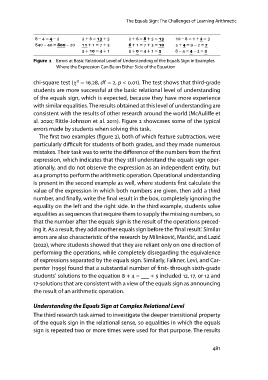Page 481 - Istenič Andreja, Gačnik Mateja, Horvat Barbara, Kukanja Gabrijelčič Mojca, Kiswarday Vanja Riccarda, Lebeničnik Maja, Mezgec Maja, Volk Marina. Ur. 2023. Vzgoja in izobraževanje med preteklostjo in prihodnostjo. Koper: Založba Univerze na Primorskem
P. 481
The Equals Sign: The Challenges of Learning Arithmetic
–=– + = + + = + = – = + =
– = – + = + + = + = +=–=
+ = + +=+= –=–=
Figure 2 Errors at Basic Relational Level of Understanding of the Equals Sign in Examples
Where the Expression Can Be on Either Side of the Equation
chi-square test (χ2 = 16.28, df = 2, p < 0.01). The test shows that third-grade
students are more successful at the basic relational level of understanding
of the equals sign, which is expected, because they have more experience
with similar equalities. The results obtained at this level of understanding are
consistent with the results of other research around the world (McAuliffe et
al. 2020; Rittle-Johnson et al. 2011). Figure 2 showcases some of the typical
errors made by students when solving this task.
The first two examples (figure 2), both of which feature subtraction, were
particularly difficult for students of both grades, and they made numerous
mistakes. Their task was to write the difference of the numbers from the first
expression, which indicates that they still understand the equals sign oper-
ationally, and do not observe the expression as an independent entity, but
as a prompt to perform the arithmetic operation. Operational understanding
is present in the second example as well, where students first calculate the
value of the expression in which both numbers are given, then add a third
number, and finally, write the final result in the box, completely ignoring the
equality on the left and the right side. In the third example, students solve
equalities as sequences that require them to supply the missing numbers, so
that the number after the equals sign is the result of the operations preced-
ing it. As a result, they add another equals sign before the ‘final result.’ Similar
errors are also characteristic of the research by Milinković, Maričić, and Lazić
(2022), where students showed that they are reliant only on one direction of
performing the operations, while completely disregarding the equivalence
of expressions separated by the equals sign. Similarly, Falkner, Levi, and Car-
penter (1999) found that a substantial number of first- through sixth-grade
students’ solutions to the equation 8 + 4 = ___ + 5 included 12, 17, or 12 and
17-solutions that are consistent with a view of the equals sign as announcing
the result of an arithmetic operation.
Understanding the Equals Sign at Complex Relational Level
The third research task aimed to investigate the deeper transitional property
of the equals sign in the relational sense, so equalities in which the equals
sign is repeated two or more times were used for that purpose. The results
481
–=– + = + + = + = – = + =
– = – + = + + = + = +=–=
+ = + +=+= –=–=
Figure 2 Errors at Basic Relational Level of Understanding of the Equals Sign in Examples
Where the Expression Can Be on Either Side of the Equation
chi-square test (χ2 = 16.28, df = 2, p < 0.01). The test shows that third-grade
students are more successful at the basic relational level of understanding
of the equals sign, which is expected, because they have more experience
with similar equalities. The results obtained at this level of understanding are
consistent with the results of other research around the world (McAuliffe et
al. 2020; Rittle-Johnson et al. 2011). Figure 2 showcases some of the typical
errors made by students when solving this task.
The first two examples (figure 2), both of which feature subtraction, were
particularly difficult for students of both grades, and they made numerous
mistakes. Their task was to write the difference of the numbers from the first
expression, which indicates that they still understand the equals sign oper-
ationally, and do not observe the expression as an independent entity, but
as a prompt to perform the arithmetic operation. Operational understanding
is present in the second example as well, where students first calculate the
value of the expression in which both numbers are given, then add a third
number, and finally, write the final result in the box, completely ignoring the
equality on the left and the right side. In the third example, students solve
equalities as sequences that require them to supply the missing numbers, so
that the number after the equals sign is the result of the operations preced-
ing it. As a result, they add another equals sign before the ‘final result.’ Similar
errors are also characteristic of the research by Milinković, Maričić, and Lazić
(2022), where students showed that they are reliant only on one direction of
performing the operations, while completely disregarding the equivalence
of expressions separated by the equals sign. Similarly, Falkner, Levi, and Car-
penter (1999) found that a substantial number of first- through sixth-grade
students’ solutions to the equation 8 + 4 = ___ + 5 included 12, 17, or 12 and
17-solutions that are consistent with a view of the equals sign as announcing
the result of an arithmetic operation.
Understanding the Equals Sign at Complex Relational Level
The third research task aimed to investigate the deeper transitional property
of the equals sign in the relational sense, so equalities in which the equals
sign is repeated two or more times were used for that purpose. The results
481


